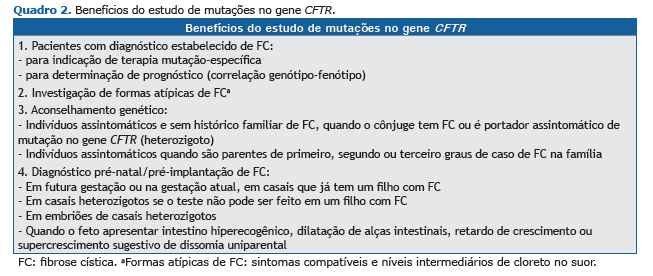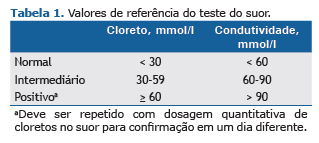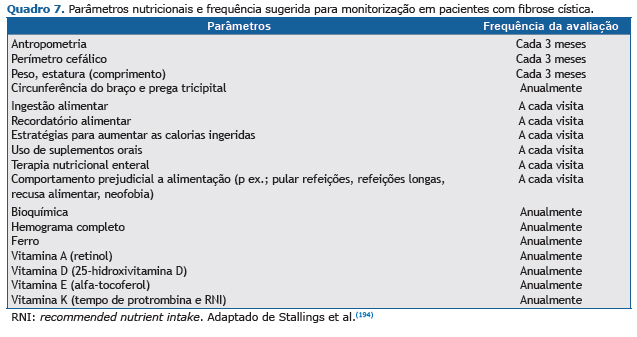

Rodrigo Abensur Athanazio1, Luiz Vicente Ribeiro Ferreira da Silva Filho2,3, Alberto Andrade Vergara4, Antônio Fernando Ribeiro5, Carlos Antônio Riedi6, Elenara da Fonseca Andrade Procianoy7, Fabíola Villac Adde2, Francisco José Caldeira Reis4, José Dirceu Ribeiro5, Lídia Alice Torres8, Marcelo Bicalho de Fuccio9, Matias Epifanio10, Mônica de Cássia Firmida11, Neiva Damaceno12, Norberto Ludwig-Neto13,14, Paulo José Cauduro Maróstica7,15, Samia Zahi Rached1, Suzana Fonseca de Oliveira Melo4, Grupo de Trabalho das Diretrizes Brasileiras de Diagnóstico e Tratamento da Fibrose Cística.
ABSTRACT
Cystic fibrosis (CF) is an autosomal recessive genetic disorder characterized by dysfunction of the CFTR gene. It is a multisystem disease that most often affects White individuals. In recent decades, various advances in the diagnosis and treatment of CF have drastically changed the scenario, resulting in a significant increase in survival and quality of life. In Brazil, the current neonatal screening program for CF has broad coverage, and most of the Brazilian states have referral centers for the follow-up of individuals with the disease. Previously, CF was limited to the pediatric age group. However, an increase in the number of adult CF patients has been observed, because of the greater number of individuals being diagnosed with atypical forms (with milder phenotypic expression) and because of the increase in life expectancy provided by the new treatments. However, there is still great heterogeneity among the different regions of Brazil in terms of the access of CF patients to diagnostic and therapeutic methods. The objective of these guidelines was to aggregate the main scientific evidence to guide the management of these patients. A group of 18 CF specialists devised 82 relevant clinical questions, divided into five categories: characteristics of a referral center; diagnosis; treatment of respiratory disease; gastrointestinal and nutritional treatment; and other aspects. Various professionals working in the area of CF in Brazil were invited to answer the questions devised by the coordinators. We used the PubMed database to search the available literature based on keywords, in order to find the best answers to these questions.
Keywords: Cystic fibrosis/diagnosis; Cystic fibrosis/therapy; Cystic fibrosis/complications; Practice guideline.
RESUMO
A fibrose cística (FC) é uma doença genética autossômica recessiva caracterizada pela disfunção do gene CFTR. Trata-se de uma doença multissistêmica que ocorre mais frequentemente em populações descendentes de caucasianos. Nas últimas décadas, diversos avanços no diagnóstico e tratamento da FC mudaram drasticamente o cenário dessa doença, com aumento expressivo da sobrevida e qualidade de vida. Atualmente, o Brasil dispõe de um programa de ampla cobertura para a triagem neonatal de FC e centros de referência distribuídos na maior parte desses estados para seguimento dos indivíduos. Antigamente confinada à faixa etária pediátrica, tem-se observado um aumento de pacientes adultos com FC tanto pelo maior número de diagnósticos de formas atípicas, de expressão fenotípica mais leve, assim como pelo aumento da expectativa de vida com os novos tratamentos. Entretanto, ainda se observa uma grande heterogeneidade no acesso aos métodos diagnósticos e terapêuticos para FC entre as diferentes regiões brasileiras. O objetivo dessas diretrizes foi reunir as principais evidências científicas que norteiam o manejo desses pacientes. Um grupo de 18 especialistas em FC elaborou 82 perguntas clínicas relevantes que foram divididas em cinco categorias: características de um centro de referência; diagnóstico; tratamento da doença respiratória; tratamento gastrointestinal e nutricional; e outros aspectos. Diversos profissionais brasileiros atuantes na área da FC foram convidados a responder as perguntas formuladas pelos coordenadores. A literatura disponível foi pesquisada na base de dados PubMed com palavras-chave, buscando-se as melhores respostas às perguntas dos autores.
Palavras-chave: Fibrose cística/diagnóstico; Fibrose cística/terapia; Fibrose cística/complicações; Guia de prática clínica.
INTRODUÇÃO












